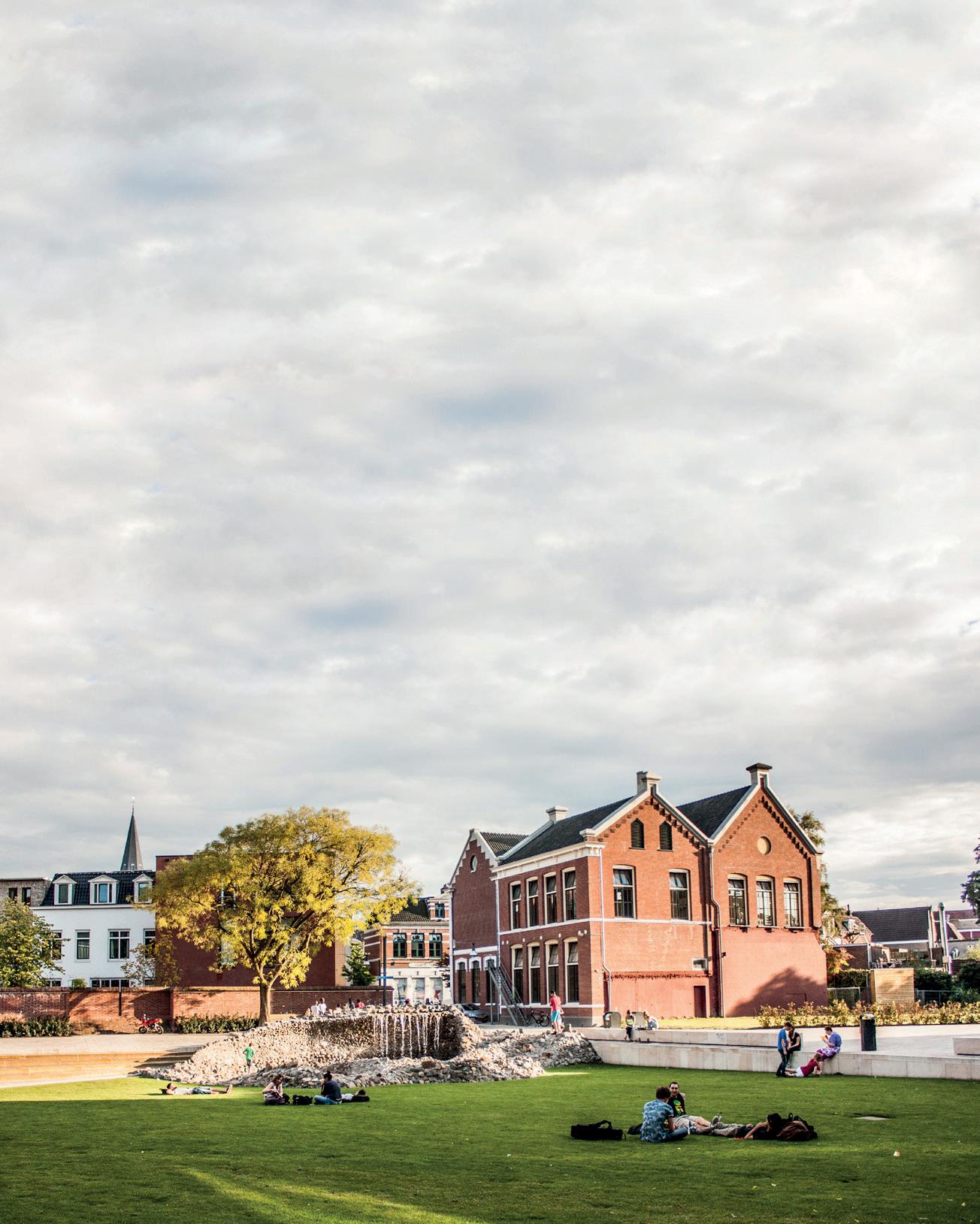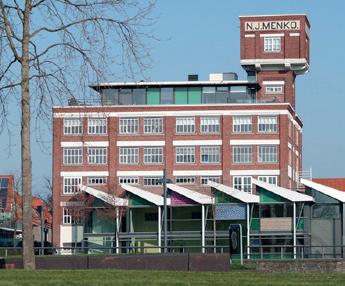
7 minute read
PUSHING BOUNDARIES
// Textile route Enschede - Gronau: biking along red priest and white lady
OLD TRACKS AND RENEWED ENERGY
IN AN OLD TURBINE HALL YOU WILL GO ON A JOURNEY THROUGH POP MUSIC AND WHERE ONCE THE LOOMS WERE RATTLING, YOU CAN MAKE YOUR OWN CREATIONS BY USING A LASER CUTTER OR A 3D-PRINTER. HOP ON YOUR BIKE AND DISCOVER HOW ENSCHEDE AND GRONAU ADDED A NEW TWIST TO THEIR SHARED TEXTILE HISTORY.
He looks at him with dismay. Like Gerrit Jan Van Heek cannot cope with the fact that he is accompanied by a notorious troublemaker. The plaque showing the strict looking textile manufacturer reminds us of the time he and his family lived in the white villa behind the Grote Kerk. Nowadays you can buy chorizo croquettes and fried pointed peppers there. The portrait of the revolutionary Che Guevara is used as a sign for the tapas restaurant. Van Heek and Guevara together on a façade: it is possible. It is a small example of how Enschede shook off its textile past, but has never forgotten about it. Wíll never be able to forget about it, because the influence of the textile industry on the city and its inhabitants was enormous.
INDUSTRIAL ACTIVITY That influence crosses the border: textile manufacturers from Enschede were closely involved in the development of the textile industry in the German city of Gronau. This shared history is shown when you get on your bike to follow the Grensoverschrijdende Textielfietsroute (textile hiking tour that crosses the border). The train station of Enschede is a suitable starting point: the construction of the railway to Münster and Dortmund via Gronau made sure the industrial activities on both sides of the border increased substantially from 1875 onwards.
Gronau

However, the two textile factories right next to the train station of Enschede are no longer there. They were dismantled in the seventies.
The more important is the industrial heritage that was preserved in the Roombeek district three decades later. At the spot where the fireworks disaster took place in 2000, you will now find a mix of old and new. Many old factories stand out among contemporary architecture, used as an art academy, an exposition hall, a school, a media centre or an apartment complex. At the Museumfabriek, where they used to fabricate cotton, you can now make your own creations by using technical gadgets like a 3D-printer or a laser cutter.
DARING A bit further down the road you will find the Rijksmuseum Twenthe, which offers an extensive overview of art from the Middle Ages until today. The museum is also a living monument for Enschede’s textile past, because the founder of the museum was manufacturer and art collector Jan Bernard van Heek. Building on his heritage, the museum now captures the time spirit with daring exhibitions.
The route leads back to the city centre, through the area where the Van Heek factory complex stretched out along the rail tracks

for one and a half kilometres. A few leftover facades still offer a hint of that era, but the new residential function of the building is far removed from the circumstances in which the labourers had to work in this former spinning mill and its adjoining warehouse.
To get rid of the filth and the sweat, the labourers could wash themselves at the swimming pool / bathhouse which Van Heek built for his employees. It used to be on the spot in the city centre where you will now find the Van Heekplein. The swimming pool was opened in 1892 and had an interior with an arched dome and cast iron pillars. Now, this grandeur can only be seen on pictures. In 1972 the sledgehammer tore down the complex to the last brick.
It was the timeframe that Willem Wilmink captured in his poem Textielstad (1976).

Nowadays you can read the poem on the façade of the Broekhuis bookstore. A time of decay and deterioration after the collapse of the textile industry. When ‘ the fortresses of industry’ had become ‘caverns, hollow and worn, where the wind has free play now’.
ARISEN Already in 1987, Willem Wilmink wrote a version that adjusted this pessimistic image. ‘What used to be a sad spectacle, has risen from the ashes like a phoenix’. For Enschede had changed unrecognizably in the meantime. It is a good thing that the melancholic original version can be found on the intersection De Graaff. That way every reader can see the huge contrast between the city in the past and the city in the present.
Together with Wilmink you can ask yourself at this spot what happened to all the manufacturers; the Van Heek family, Ter Kuiles, Blijdensteins. The famous hotel De Graaff could no longer exist when these families closed their factories. It vanished in time. The beautiful villa Baurichter, which is in the same square and was once the home of a member of the Van Heek family, is now a Mexican restaurant. But only a little bit further you will find their presence, even if it is only a small plaque with the family name. ‘Van Heek Holding en Beheer’ it says between the names of some companies. The family weapon of the Blijdenstein family above the door refers to banker B.W. Blijdestein, founder of the Twentsche Bank that was located here as a an intersection for the textile manufacturers’ trade.
A stone’s throw from this monumental building you will find Alfons Ariëns, lost in his thoughts. The statue honours the ‘red’ priest as foreman of the catholic labour movement. Behind him a huge banner announces yet another transformation in the city centre of Enschede: the former hospital Stadsmaten will be ‘the most funky place to meet, learn and live’. MIGHTY SIZE The developments take a little longer in Gronau, or so it seems. In the area around the train station you will see several factory buildings waiting for a new destination. This may give you the image of faded glory as Willem Wilmink described in his poem. On the other hand, you will still get a good impression of the mighty size and influence this industry once had.
Standing on the modern Bogenbrücke you can see textile factories everywhere. From the former office of the firm Mathieu van Delden- now a proud innovation centretill The White Lady (De Witte Dame), the nickname of the former spinning mill that was owned by Gerrit van Delden. Designed by Arend Beltman who lived in Enschede and was the in-house architect of the textile manufacturers. The lady still looks majestic with her beautiful water tower. However, decay is inevitable, while private owners keep searching for ways to realise a makeover that the city council will approve.

GREEN PYRAMID A makeover was approved in other places. Like at the site of Baumwoll Spinnerei Gronau BSG, now a large wholesale market in foods and products for the catering industry. The vast factory area of Mathieu van Delden has been a park since the Landesgartenschau Gronau/Losser was held here in 2003. The green pyramid that rises above the flowerbeds, ponds and playgrounds was built with debris from the dismantled factory. The top offers a nice view. For those who need a bigger challenge there is the stair tower of the spinning building, which was saved and now has a climbing wall.
ROCK’N’POPMUSEUM The most striking example is the transformation from the former turbine building to the rock’n’popmuseum. A logical destination knowing that the colourful musician Udo Lindenberg was

born in Gronau. In the recently renewed museum you will go on a multimedia journey through the history of rock and pop music. The bronze statue of Mathieu van Delden watches it from a distance, standing on his pedestal in the park. He has no choice, just like Gerrit Jan van Heek in Enschede. Their days are over, but their names live on.










